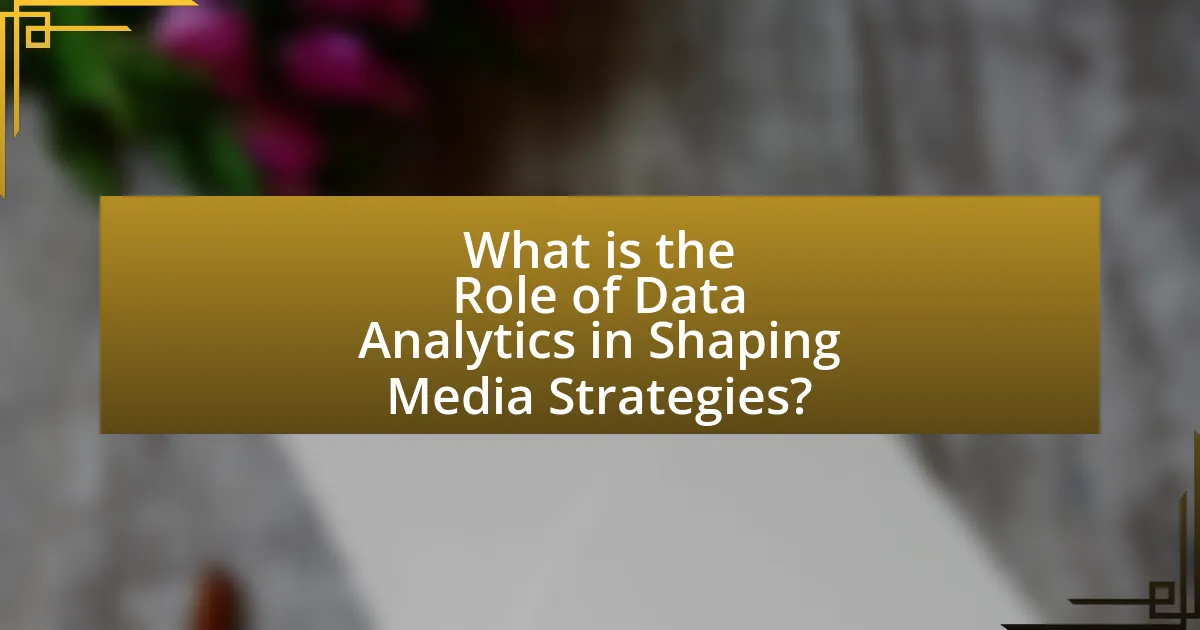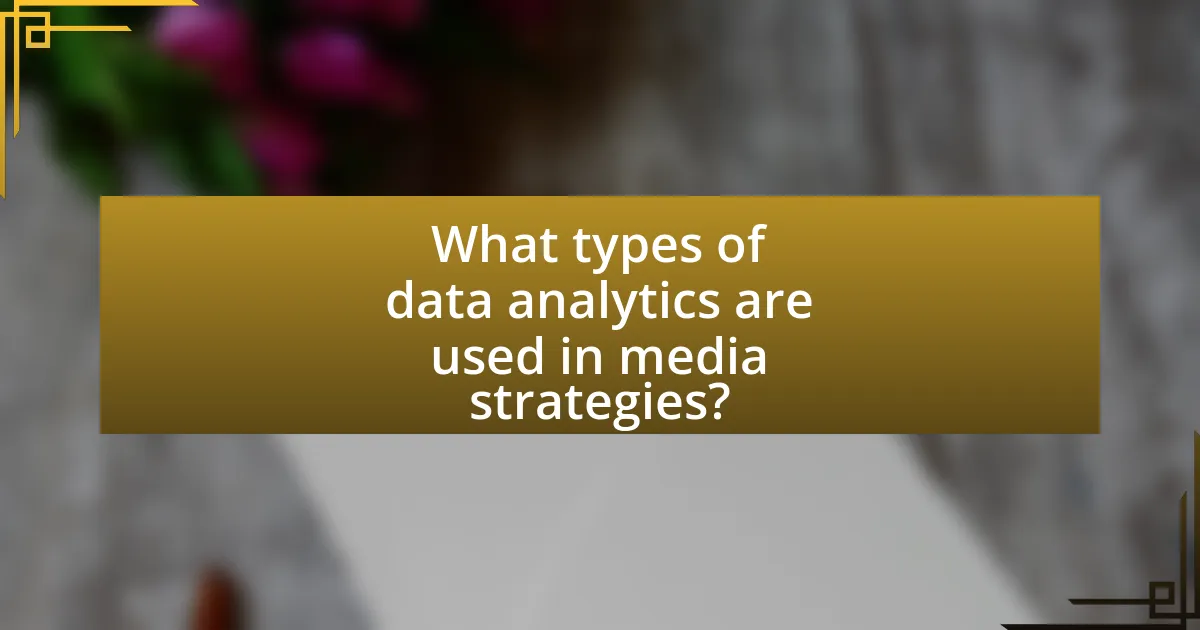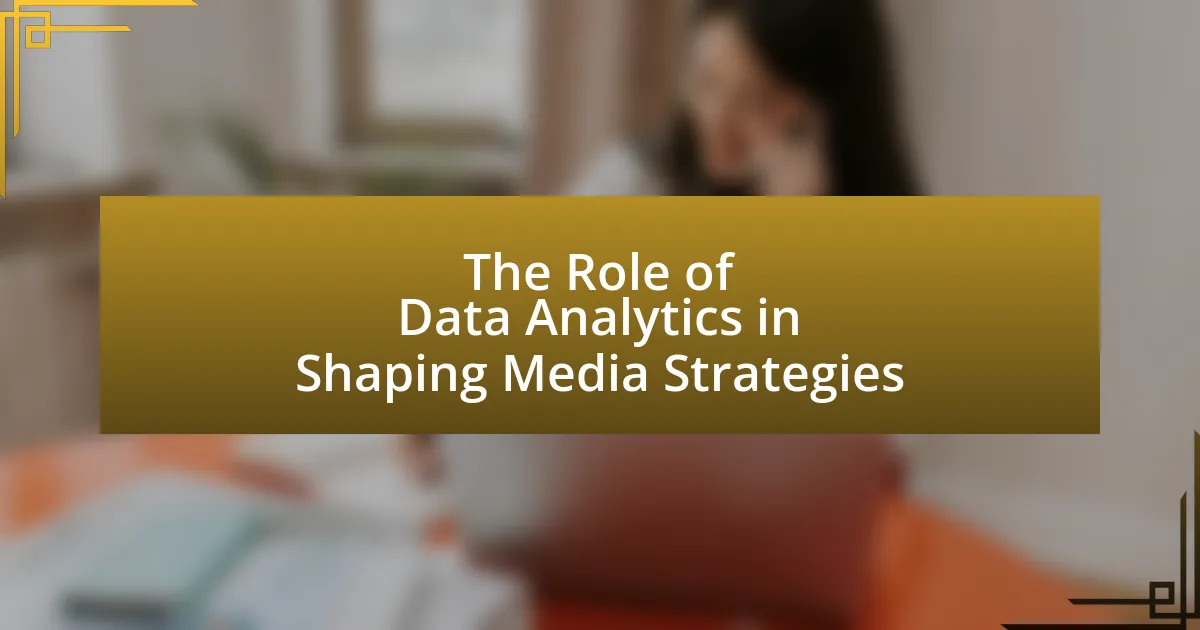Data analytics is a pivotal element in shaping media strategies, enabling organizations to make informed, data-driven decisions that enhance audience targeting and content effectiveness. The article explores how data analytics influences media strategy development through audience behavior analysis, the key components involved in data analytics, and the impact of data-driven insights on decision-making. It also addresses the essential role of data analytics in modern media strategies, the challenges faced without it, and the various types of analytics utilized, including descriptive, predictive, and prescriptive analytics. Furthermore, the article outlines best practices for implementing data analytics, fostering a data-driven culture, and avoiding common pitfalls, ultimately emphasizing the importance of leveraging data analytics for improved audience engagement and revenue growth in the media industry.

What is the Role of Data Analytics in Shaping Media Strategies?
Data analytics plays a crucial role in shaping media strategies by enabling organizations to make data-driven decisions that enhance audience targeting and content effectiveness. By analyzing audience behavior, preferences, and engagement metrics, media companies can tailor their content and advertising strategies to meet the specific needs of their target demographics. For instance, a study by Nielsen found that data-driven marketing can lead to a 20% increase in sales, demonstrating the tangible benefits of leveraging analytics in media planning. Furthermore, real-time analytics allow for agile adjustments to campaigns, optimizing performance and maximizing return on investment.
How does data analytics influence media strategy development?
Data analytics significantly influences media strategy development by providing insights into audience behavior and preferences. By analyzing data from various sources, such as social media interactions, website traffic, and viewer demographics, media strategists can identify trends and tailor content to meet audience needs. For instance, a study by Nielsen found that data-driven media strategies can increase engagement rates by up to 30%, demonstrating the effectiveness of leveraging analytics in decision-making processes. This data-driven approach allows for more precise targeting, optimizing ad spend, and improving overall campaign performance.
What are the key components of data analytics in media?
The key components of data analytics in media include data collection, data processing, data analysis, and data visualization. Data collection involves gathering information from various sources such as social media, audience surveys, and viewership metrics. Data processing transforms raw data into a usable format, often through cleaning and organizing the data. Data analysis applies statistical and computational techniques to interpret the processed data, revealing trends and insights about audience behavior and content performance. Finally, data visualization presents these insights in graphical formats, making it easier for stakeholders to understand and make informed decisions. These components collectively enable media organizations to optimize their strategies and enhance audience engagement.
How do data-driven insights impact decision-making in media?
Data-driven insights significantly enhance decision-making in media by providing actionable intelligence that informs content creation, audience targeting, and advertising strategies. For instance, media companies utilize analytics to understand viewer preferences and behaviors, enabling them to tailor programming that resonates with specific demographics. According to a report by PwC, 70% of media executives believe that data analytics is crucial for improving audience engagement and driving revenue growth. This reliance on data allows organizations to make informed decisions that optimize resource allocation and maximize return on investment.
Why is data analytics essential for modern media strategies?
Data analytics is essential for modern media strategies because it enables organizations to make data-driven decisions that enhance audience engagement and optimize content delivery. By analyzing viewer behavior, preferences, and trends, media companies can tailor their strategies to meet the specific needs of their target audience. For instance, a study by Nielsen found that 63% of consumers prefer personalized content, which can be effectively achieved through data analytics. This approach not only improves user satisfaction but also increases the efficiency of marketing campaigns, leading to higher return on investment.
What challenges do media companies face without data analytics?
Media companies face significant challenges without data analytics, including an inability to understand audience preferences and behavior. This lack of insight leads to ineffective content strategies, resulting in lower engagement and reduced advertising revenue. For instance, a study by PwC indicates that companies leveraging data analytics can increase their revenue by up to 15% through targeted marketing and content personalization. Additionally, without data analytics, media companies struggle to measure the effectiveness of their campaigns, making it difficult to optimize resources and improve return on investment. This ultimately hampers their competitiveness in a rapidly evolving digital landscape.
How does data analytics enhance audience targeting and engagement?
Data analytics enhances audience targeting and engagement by enabling organizations to analyze consumer behavior and preferences effectively. By leveraging data from various sources, such as social media interactions, website analytics, and purchase history, businesses can segment their audience into distinct groups based on demographics, interests, and behaviors. This segmentation allows for personalized marketing strategies that resonate with specific audience segments, leading to higher engagement rates. For instance, a study by McKinsey & Company found that companies utilizing data-driven marketing strategies can achieve a 15-20% increase in sales. This demonstrates that data analytics not only refines targeting efforts but also significantly boosts engagement through tailored content and communication strategies.

What types of data analytics are used in media strategies?
Media strategies utilize several types of data analytics, including descriptive analytics, predictive analytics, and prescriptive analytics. Descriptive analytics focuses on summarizing historical data to understand past performance, such as audience engagement metrics and content reach. Predictive analytics employs statistical models and machine learning techniques to forecast future trends, enabling media planners to anticipate audience behavior and optimize content delivery. Prescriptive analytics goes a step further by recommending actions based on data insights, helping media strategists make informed decisions about resource allocation and campaign adjustments. These analytics types collectively enhance the effectiveness of media strategies by providing actionable insights derived from data analysis.
How do descriptive analytics contribute to media planning?
Descriptive analytics contribute to media planning by providing insights into past performance and audience behavior, enabling marketers to make informed decisions. By analyzing historical data, such as previous campaign results and audience engagement metrics, media planners can identify trends and patterns that inform future strategies. For instance, a study by Nielsen found that campaigns utilizing historical performance data improved targeting accuracy by 30%, leading to more effective media allocation. This data-driven approach allows for optimization of media spend and enhances the overall effectiveness of marketing efforts.
What insights can be gained from historical data analysis?
Historical data analysis provides insights into trends, patterns, and behaviors over time, enabling organizations to make informed decisions. By examining past data, businesses can identify successful strategies and areas for improvement, leading to optimized media campaigns. For instance, a study by the Pew Research Center found that analyzing historical audience engagement data can reveal which content types resonate most with specific demographics, allowing for targeted marketing efforts. Additionally, historical data can help predict future outcomes, as demonstrated by the use of past sales data to forecast seasonal trends, enhancing inventory management and promotional strategies.
How does descriptive analytics inform content creation?
Descriptive analytics informs content creation by analyzing historical data to identify trends and audience preferences. This analysis allows content creators to tailor their material to meet the specific interests and behaviors of their target audience, enhancing engagement and relevance. For instance, a study by the Content Marketing Institute found that 70% of marketers use data analytics to refine their content strategies, demonstrating the effectiveness of data-driven insights in shaping content that resonates with viewers.
What role does predictive analytics play in media strategies?
Predictive analytics plays a crucial role in media strategies by enabling organizations to forecast audience behavior and optimize content delivery. This analytical approach utilizes historical data and statistical algorithms to identify patterns, allowing media companies to tailor their strategies effectively. For instance, a study by McKinsey & Company found that companies leveraging predictive analytics can improve their marketing ROI by up to 15-20%. By anticipating viewer preferences and engagement trends, media strategies can be refined to enhance audience targeting and increase overall effectiveness.
How can predictive models forecast audience behavior?
Predictive models forecast audience behavior by analyzing historical data to identify patterns and trends that inform future actions. These models utilize algorithms that process variables such as demographics, past interactions, and engagement metrics to predict how audiences will respond to various media strategies. For instance, a study by the Journal of Marketing Research found that predictive analytics can improve marketing campaign effectiveness by up to 20% by accurately targeting consumer preferences and behaviors. This data-driven approach enables media strategists to tailor content and advertising efforts, ultimately enhancing audience engagement and satisfaction.
What are the benefits of using predictive analytics in campaign planning?
Predictive analytics in campaign planning enhances decision-making by providing data-driven insights that forecast future outcomes. This approach allows marketers to identify target audiences more accurately, optimize resource allocation, and tailor messaging to increase engagement. For instance, a study by McKinsey & Company found that companies using predictive analytics can improve marketing ROI by up to 15-20%. Additionally, predictive models can analyze historical data to anticipate customer behavior, enabling proactive adjustments to campaigns that lead to higher conversion rates.

How can media companies effectively implement data analytics?
Media companies can effectively implement data analytics by integrating advanced analytics tools into their content creation and distribution processes. This integration allows for real-time audience insights, enabling companies to tailor content to viewer preferences and optimize advertising strategies. For instance, according to a 2021 report by PwC, media companies that leverage data analytics can increase their revenue by up to 15% through targeted marketing and personalized content delivery. By utilizing data visualization and machine learning algorithms, media companies can also enhance decision-making processes, leading to improved operational efficiency and audience engagement.
What tools and technologies are available for data analytics in media?
Data analytics in media utilizes various tools and technologies, including Google Analytics, Tableau, and Adobe Analytics. Google Analytics provides insights into website traffic and user behavior, enabling media companies to optimize content and marketing strategies. Tableau offers data visualization capabilities, allowing users to create interactive dashboards that present complex data in an understandable format. Adobe Analytics focuses on customer journey analysis, helping media organizations track user interactions across multiple platforms. These tools collectively enhance decision-making and strategy formulation in the media industry by providing actionable insights derived from data analysis.
How do these tools integrate with existing media systems?
Data analytics tools integrate with existing media systems by utilizing APIs and data connectors that facilitate seamless data exchange. These tools can pull data from various media platforms, such as social media, streaming services, and content management systems, allowing for real-time analysis and reporting. For instance, platforms like Google Analytics and Tableau can connect to media systems to provide insights on audience engagement and content performance, enhancing decision-making processes. This integration is supported by the widespread adoption of standardized data formats and protocols, which ensure compatibility across different systems, thereby streamlining workflows and improving operational efficiency.
What are the best practices for selecting data analytics tools?
The best practices for selecting data analytics tools include assessing business needs, evaluating tool capabilities, considering integration options, and analyzing total cost of ownership. Businesses should first identify specific objectives and requirements to ensure the selected tool aligns with their goals. Evaluating capabilities involves examining features such as data visualization, reporting, and machine learning functionalities, which are crucial for effective analysis. Integration options are important as tools must seamlessly connect with existing systems to facilitate data flow. Lastly, analyzing total cost of ownership, including licensing, maintenance, and training costs, ensures that the investment is sustainable and provides a good return. These practices are supported by industry reports indicating that organizations that align tool selection with strategic goals achieve better analytics outcomes.
How can media organizations foster a data-driven culture?
Media organizations can foster a data-driven culture by integrating data analytics into their decision-making processes and promoting data literacy among staff. This involves providing training programs that enhance employees’ skills in data interpretation and analysis, enabling them to leverage insights for content creation and audience engagement. For instance, organizations like The New York Times have successfully implemented data-driven strategies by utilizing audience metrics to tailor their reporting and improve reader engagement. Additionally, establishing cross-functional teams that include data analysts, journalists, and marketing professionals can facilitate collaboration and ensure that data insights are effectively utilized across departments. This approach not only enhances the quality of content but also aligns media strategies with audience preferences, ultimately driving better business outcomes.
What training and resources are necessary for staff?
Staff in media organizations require training in data analytics tools and techniques, as well as access to relevant software and databases. This training should include courses on data interpretation, statistical analysis, and visualization tools like Tableau or Google Analytics. Additionally, resources such as online tutorials, workshops, and access to industry reports are essential for staff to stay updated on best practices and emerging trends in data analytics. Research indicates that organizations that invest in data analytics training see a 5-6% increase in productivity and decision-making efficiency, highlighting the importance of these resources.
How can leadership support data-driven decision-making?
Leadership can support data-driven decision-making by fostering a culture that prioritizes data utilization in strategic planning. This involves providing access to relevant data analytics tools and training employees on how to interpret and leverage data effectively. Research indicates that organizations with strong data-driven cultures are 5-6% more productive and profitable than their competitors, as highlighted in a study by McKinsey & Company. By actively promoting data literacy and integrating data insights into everyday decision-making processes, leadership can enhance organizational performance and adaptability in media strategies.
What are the common pitfalls in using data analytics for media strategies?
Common pitfalls in using data analytics for media strategies include over-reliance on data without context, misinterpretation of data, and neglecting data quality. Over-reliance on data can lead to decisions that ignore qualitative insights, which are crucial for understanding audience behavior. Misinterpretation of data often occurs due to a lack of statistical knowledge, resulting in incorrect conclusions that can misguide strategy. Additionally, neglecting data quality can lead to inaccurate analyses; for instance, a study by the Data Warehousing Institute found that poor data quality costs organizations an average of $15 million annually. These pitfalls can significantly undermine the effectiveness of media strategies.
How can organizations avoid misinterpretation of data?
Organizations can avoid misinterpretation of data by implementing clear data governance policies and ensuring data literacy among employees. Clear governance policies establish standardized definitions, data collection methods, and reporting formats, which minimize ambiguity. For instance, a study by the Data Management Association found that organizations with strong data governance frameworks experience 30% fewer data-related errors. Additionally, training employees in data interpretation enhances their ability to analyze and contextualize data accurately, reducing the risk of misinterpretation.
What strategies can mitigate data privacy concerns?
Implementing robust data encryption is a key strategy to mitigate data privacy concerns, as it protects sensitive information from unauthorized access. Organizations can also adopt strict access controls, ensuring that only authorized personnel can access personal data, thereby reducing the risk of breaches. Regular audits and compliance checks with data protection regulations, such as GDPR, further enhance privacy measures by ensuring adherence to legal standards. Additionally, providing transparency to users about data collection and usage fosters trust and allows individuals to make informed choices regarding their data. According to a 2021 study by the International Association of Privacy Professionals, organizations that prioritize these strategies experience significantly lower rates of data breaches, reinforcing the effectiveness of these approaches in safeguarding privacy.
What practical steps can media companies take to leverage data analytics effectively?
Media companies can leverage data analytics effectively by implementing a structured approach that includes data collection, analysis, and actionable insights. First, they should invest in robust data collection tools to gather audience metrics, engagement statistics, and content performance data. For instance, utilizing platforms like Google Analytics can provide insights into user behavior and preferences.
Next, media companies should employ advanced analytics techniques, such as predictive modeling and machine learning, to identify trends and forecast audience needs. According to a report by McKinsey, organizations that utilize data-driven decision-making are 23 times more likely to acquire customers and 6 times more likely to retain them.
Finally, it is crucial for media companies to create a culture of data-driven decision-making by training staff on data interpretation and encouraging collaboration between data analysts and content creators. This integration ensures that insights derived from data analytics directly inform content strategy and marketing efforts, leading to improved audience engagement and revenue growth.

Leave a Reply